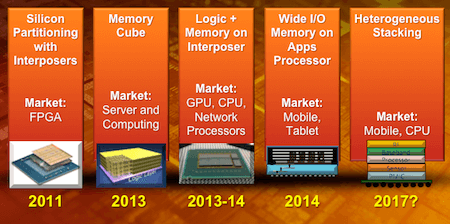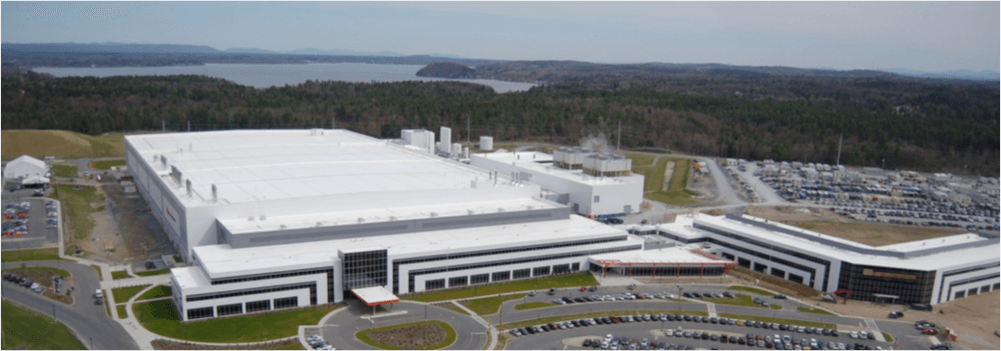As 2.5D and 3D IC technologies round the ten-year development mark and volume manufacturing keeps getting pushed just beyond our reach, I’m always looking for a new angle to cover while waiting for ‘The Big One’. As usual, SEMICON West provided the opportunity not only to listen to what invited speakers and panelists have to say on the topic, but also bounce thoughts off many 3D IC technology experts attending the event. More and more, I’m realizing that the “big one” is more likely to be incremental “little ones” and then one day someone will notice that 3D ICs are enabling everything.
While 3D IC progress has seemly slowed to a snails pace, in reality technology hurdles such as thin wafer handling and test are being overcome and fingers now to point almost exclusively to supply chain and cost as the main roadblocks to commercialization. But even then, it depends on who’s doing the talking. Pragmatists continue to seek out alternative solutions that leverage the existing infrastructure, thereby pushing out the need for TSVs, while devotees of 2.5D and 3D looked to the entire ecosystem to put cost into perspective.
In his opening keynote address, Foundry Driven Innovation into the Mobility Era, GLOBALFOUNDRIES CEO, Ajit Minocha noted that by 2016, the mobility market will be twice that of the PC market, and will drive new requirements in power performance and features such as data rates, higher resolution screens, multicore processors, and thinner form factors. He says he “big five” technology challenges our industry faces to meet these requirements includes device architectures/materials, lithography scaling, packaging, and the transition to 450mm wafer sizes.
Additionally, he said cost-of-ownership is driving new dynamics such that only a handful of top tier companies (GLOBALFOUNDRIES, Intel, TSMC, Samsung and IBM) will be able to absorb the cost of scaling to 14nm and beyond. “Cost has always been implicit. I want to make it explicit. Cost is very important,” said Minocha, adding that time-to-market and time-to-volume has given way to time-to-…well, EVERYTHING.
But he’s mainly talking about the cost of scaling to further nodes, and says that in packaging, normal economics are dead and 2.5D and 3D ICs offer a value proposition as an alternative to scaling. At advanced nodes, lithography starts to dominate wafer cost. That’s why GLOBALFOUNDRIES includes 2.5D and 3D ICs in its total solution. He provided this roadmap of the company’s integration of 2.5D and 3D IC packaging:

Because of the complexity of technology and economic challenges across the board, collaboration is required across the supply chain. Minocha declared that the IDM and Foundry 1.O model is dead. Why? The IDM model fosters a slower rate of change, and solutions optimized to one product. “The best solutions rarely come from an insulated team,” noted Minocha. Additionally, he pointed out that Foundry 1.O is not tapping global R&D talent and has a lack of flexibility and transparency. Furthermore, single-source supply adds geographical risk and lack of innovation. For some time, GLOBALFOUNDRIES has been promoting its “Foundry 2.0” model as the collaborative approach that’s needed to handle this changing landscape.
During the press roundtable following the keynote, I spoke with Minocha and Mike Noonan, GLOBALFOUNDRIES executive V.P. Global Marketing and Sales, about how 2.5D and 3D ICs fit into this collaborative approach. Noonan explained that as the value is going to be in the package, whether we’re talking about system-in-package (SiP), 2.5D or 3D, GLOBALFOUNDRIES has to have a good way for customers to manage it. He also said its important to examine the system level cost. “This is a golden age for being a systems architect,” he commented. “2.5D and 3D for the right applications are cost-effective. 2.5D becomes interesting when you think about active interposers. Passive interposers just add cost, but it offers the best possible technology on an active interposer.” Ultimately, it depends on what the customer wants to do. Global Foundries Technology Development Center (TDC) allows customers to get involved early on, at the conception level to establish roadmaps. With its TDC, explained Minocha and Noonan, GLOBALFOUNDRIES aims to create a virtual IDM environment within a foundry. This “sole source partnership” offers the customer the flexibility to take technology and work with other suppliers. In this way, everybody wins.
“It takes an ecosystem,” says Minocha. “GLOBALFOUNDRIES has learned how to work collectively with everybody to support the ecosystem.” ~ F.v.T.























